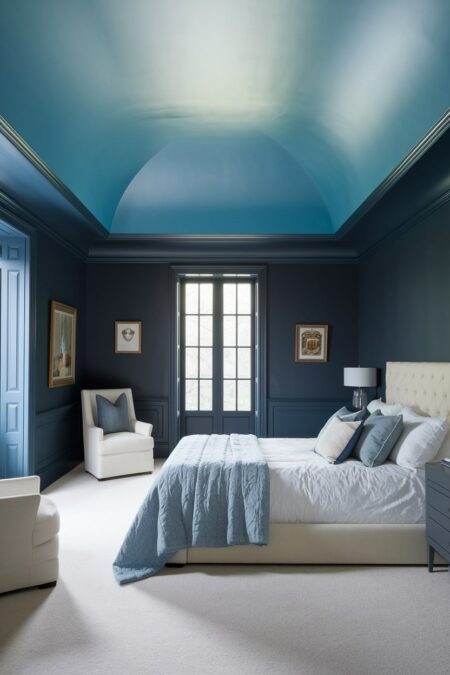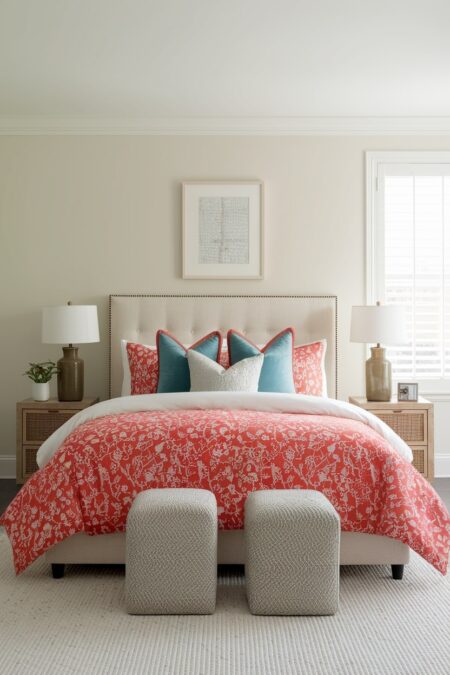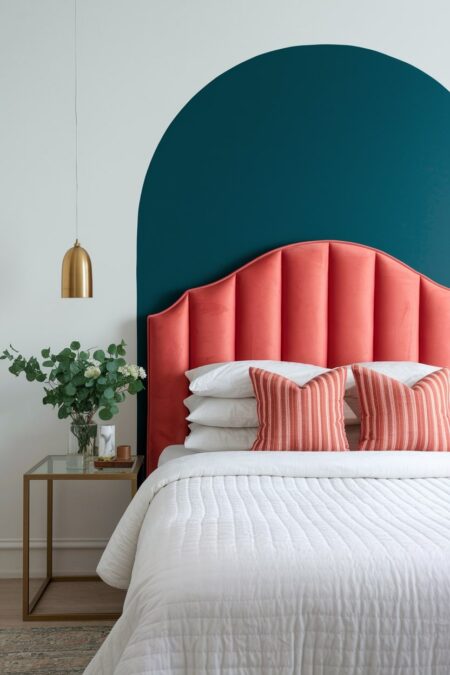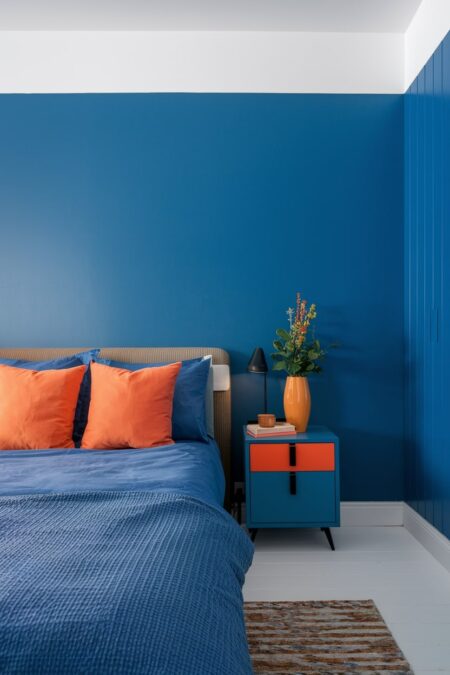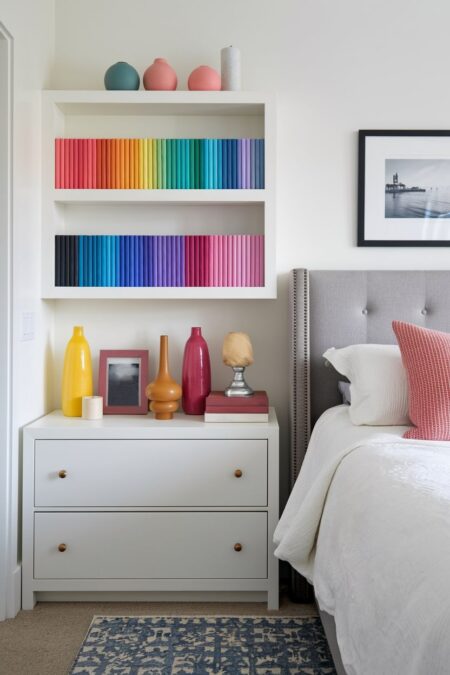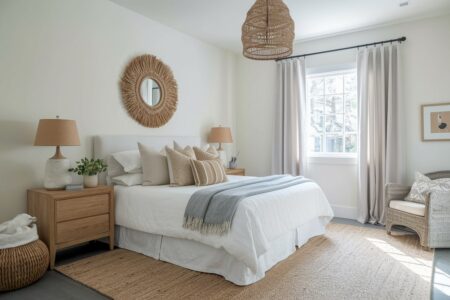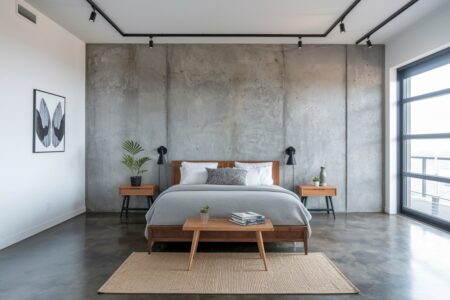Your bedroom is more than just a place to sleep; it’s a personal sanctuary where you begin and end each day. The colors that surround you in this intimate space can significantly influence your mood, energy levels, and overall sense of well-being. While neutral palettes have their place, embracing color can transform your room into a vibrant, personalized oasis. Moving beyond conventional whites and beiges opens up a world of design possibilities that can reflect your unique personality. Here are inspiring ideas for introducing beautiful, mood-boosting color into your bedroom.
-
01 of 12
The Dynamic Accent Wall
Creating a single accent wall is a classic and effective strategy for introducing a bold color without overwhelming the entire room. This technique works exceptionally well on the wall behind your bed, as it frames the most important piece of furniture and establishes a clear focal point. When you are lying in bed, the color is behind you, allowing for a restful state of mind while still infusing the bedroom with dynamic energy.
To successfully execute this idea, consider deep, saturated hues like emerald green, navy blue, or a rich terracotta. These shades add a layer of sophistication and depth. Pair the statement wall with more subdued colors on the other three walls and neutral bedding to create a balanced and harmonious design. This approach ensures the accent color stands out as an intentional and impactful feature.
-
02 of 12
The Unexpected Statement Ceiling
Often referred to as the “fifth wall,” the ceiling provides a vast, uninterrupted canvas for color. Painting your ceiling can be a surprisingly transformative design choice that draws the eye upward and adds an element of architectural interest. A soft, pale blue can mimic the sky, creating an open and airy atmosphere that is perfect for a serene bedroom retreat.
For a more dramatic and cozy effect, especially in rooms with high ceilings, a darker color like charcoal gray or even a deep plum can create a sense of intimacy and comfort. To elevate the look further, consider a high-gloss finish. This reflects light around the room, adding a subtle shimmer and a touch of glamour that makes the space feel truly special and custom-designed.
-
03 of 12
A Monochromatic Masterpiece
A monochromatic color scheme involves using various tints, tones, and shades of a single color to create a cohesive and sophisticated look. This approach is far from boring; when done correctly, it results in a rich, layered environment that feels both calming and visually interesting. The key to mastering this style is to incorporate a wide range of textures to prevent the design from appearing flat.
Imagine a bedroom designed around the color sage green. You could have walls in a soft, muted sage, a velvet headboard in a deeper forest green, linen bedding in a light minty shade, and a wool rug that incorporates several green tones. This layering of materials and shades provides the depth and complexity needed to make a single-color palette feel luxurious and thoughtfully curated.
-
04 of 12
Bedding as the Colorful Centerpiece
If painting walls feels like too much of a commitment, you can use your bed as the primary vehicle for color. This is a flexible and budget-friendly way to experiment with different palettes. Start with a neutral foundation, such as walls painted in a soft off-white or light gray, and let your bedding do all the talking.
Select a duvet cover or comforter in a vibrant color or a bold pattern that you love. From there, build layers with decorative pillows and throw blankets in complementary or contrasting hues. You can easily swap these elements out with the changing seasons or as your design preferences evolve, giving your room a fresh look with minimal effort.
-
05 of 12
Modern Two-Tone Walls
For a contemporary and graphic approach to color, consider creating two-tone walls in the bedroom. This technique involves painting the wall in two different colors, often divided by a crisp horizontal line. A popular method is to use a darker, more grounding color on the bottom portion of the wall and a lighter, airier shade on the top.
This design trick can create the illusion of higher ceilings and adds a unique architectural dimension to a plain room. The dividing line is typically placed at about one-third or two-thirds of the way up the wall. You can leave the line sharp and clean for a modern feel or add a thin piece of molding, like a chair rail, for a more traditional look.
-
06 of 12
Vibrant and Elegant Window Treatments
Windows present a wonderful opportunity to introduce a significant splash of color and pattern. Your choice of curtains or blinds can tie the entire bedroom’s color scheme together. Instead of opting for neutral window treatments, consider them a key decorative element that contributes to the room’s overall personality.
Floor-to-ceiling drapes in a saturated jewel tone or a large-scale botanical print can frame your window and become a stunning visual feature. When selecting a fabric, ensure it complements other accents within the room, such as throw pillows or a piece of artwork. This coordination creates a polished and intentional design that feels both colorful and cohesive.
-
07 of 12
The Art of Layered Textiles
Beyond your bedding, other textiles like rugs and throws play a crucial role in building a colorful and comfortable bedroom. A large area rug is an excellent starting point, as it can anchor the room and define the color palette. Choose a rug with a pattern that incorporates several colors you’d like to feature in the space.
Once the rug is in place, pull two or three of its prominent colors to use for other accessories. For instance, if your rug features shades of blush pink, navy, and gold, you can find throw pillows in blush and a navy blanket for the foot of the bed. This layering technique adds warmth, texture, and a harmonious flow of color throughout the room.
-
08 of 12
A Bold Statement Furniture Piece
You don’t need to paint every surface to create a colorful bedroom. Sometimes, a single piece of statement furniture in a standout hue is all it takes. Against a neutral backdrop, a brightly colored piece can serve as an artistic and functional focal point, injecting personality and style into the space.
Consider finding a vintage dresser and painting it a vibrant cobalt blue, or invest in an upholstered armchair in a cheerful mustard yellow for a reading nook. Even a pair of nightstands painted in a soft lavender can add a subtle yet impactful dose of color. This approach allows the furniture itself to become a piece of art.
-
09 of 12
The Power of a Colorful Headboard
The headboard is a natural focal point in any bedroom, making it the perfect candidate for a splash of color. An upholstered headboard offers a fantastic opportunity to introduce both color and texture. You can choose a luxurious fabric like velvet in a deep teal or a durable linen in a sunny coral to instantly elevate your design.
For a more budget-friendly or DIY approach, you can paint an existing wooden headboard or even create the illusion of one by painting an arch or a rectangle on the wall directly behind your bed. This defines the space and adds a custom design element without the need for new furniture.
-
10 of 12
Harmonious Analogous Color Schemes
For a design that is colorful yet inherently calming, explore an analogous color scheme. This involves using colors that sit next to each other on the color wheel, such as blue, blue-green, and green. Because the colors are related, they create a serene and cohesive feel with minimal contrast.
To implement this idea effectively, follow the 60-30-10 rule. Use one color as the dominant shade for about 60% of the room (typically the walls), a secondary color for 30% (perhaps in bedding and curtains), and a third color as an accent for the final 10% (in decorative objects and art). This creates a balanced and visually pleasing composition.
-
11 of 12
High-Energy Complementary Colors
If you’re aiming for a more energetic and vibrant bedroom, a complementary color scheme is an excellent choice. This involves pairing colors that are directly opposite each other on the color wheel, such as blue and orange or purple and yellow. The high contrast between these colors creates a lively and dynamic atmosphere.
To prevent the combination from becoming overwhelming, it’s best to use the colors in unequal proportions. For example, you could design a primarily blue room with neutral walls and blue bedding, then introduce small, powerful pops of orange through throw pillows, a vase on the nightstand, or a piece of abstract art. These small accents will stand out beautifully against the cooler background.
-
12 of 12
Curated Bookshelves and Decor
Finally, don’t overlook the decorative potential of the smaller items in your bedroom. Your bookshelves, nightstand, and dresser surfaces are perfect places to create curated moments of color. This approach allows you to add personality and visual interest in a controlled and easily adjustable way.
Try arranging your books by the color of their spines to create a striking rainbow effect on a shelf. On your dresser, group together a collection of vases in varying shades of a single color, or create a vignette with framed photos, candles, and trinkets that share a cohesive color story. These thoughtful details demonstrate a sophisticated understanding of color and make the space feel truly your own.


